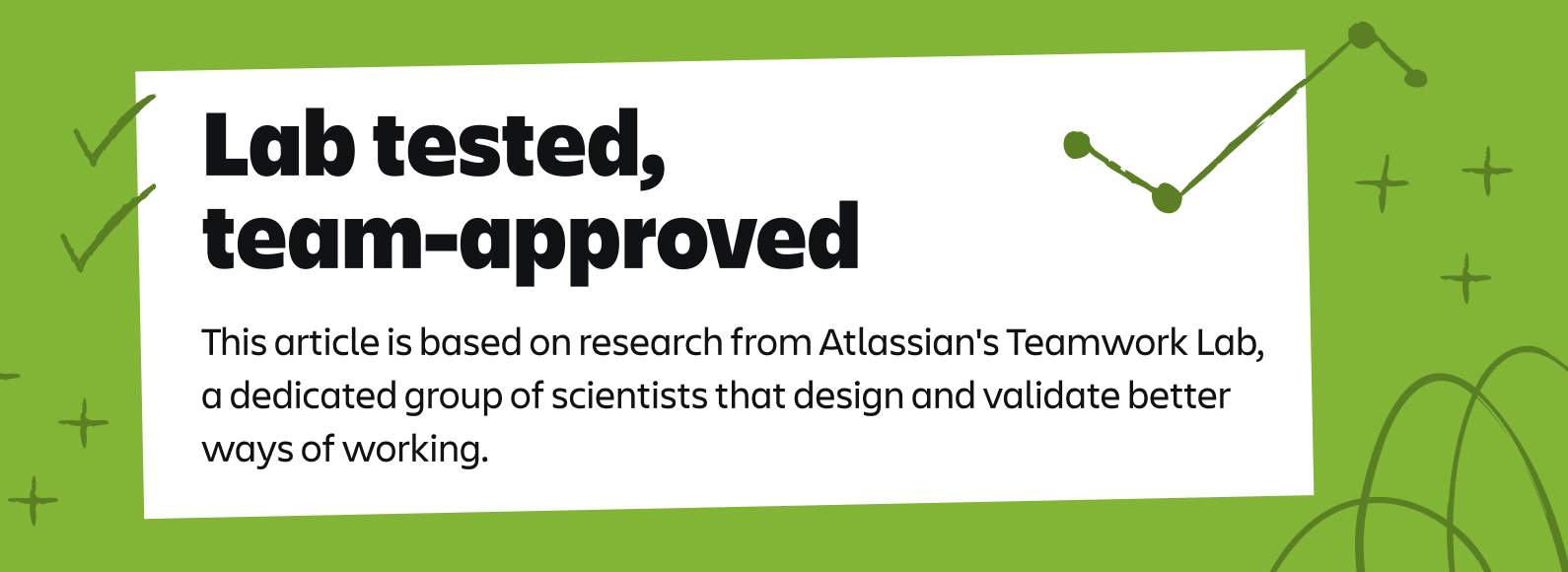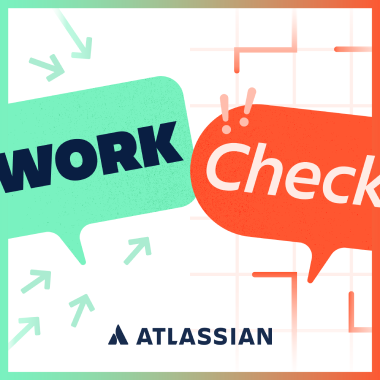Ever feel like your team is scrambling because no one agrees on what’s most important? Imagine how much easier work would be if everyone was crystal-clear about priorities. You’d move forward together, make faster decisions, and finally have space to create something you’re truly proud of.
But for leaders, creating and maintaining that clarity is a tall order. Goals vanish into documents nobody looks at, teams interpret priorities differently, and suddenly everyone’s pulling in opposite directions. Even small misunderstandings now can turn into major “Wait, what?” moments later.
Take marketing, for example. Should your team focus on top-of-funnel awareness or bottom-of-funnel conversions? If you haven’t taken the lead on clarifying what’s most important, your team is left guessing – and no matter how hard everyone works, it can feel like you’re failing (and flailing).
This confusion around priorities frustrates everyone. It leads to wasted energy, stalled projects, and missed deadlines. Still, Fortune 500 executives estimate that only 24% of their teams are doing mission-critical work. As one VP put it:
If all teams worked on mission-critical work in lockstep, results would be on time, we’d win the market, and we wouldn’t waste effort.
At Atlassian, we’ve spent over two decades helping teams work more efficiently and effectively. Our data shows top-performing teams don’t just set goals – they set great ones (more details on that below). They build simple habits that keep those goals clear, actionable, and continuously relevant.
Here’s what we’ve learned about setting and reaching the right goals, the right way.
Turn your vision into wins by setting great goals
Start by making sure every goal – and every project or task tied to it – directly supports your company’s strategic priorities. If it doesn’t, why are you doing it?
Put goals where everyone can access them, and talk about where they’ll get you. Regular updates on goals and progress will keep your team locked in on what actually moves the needle.
When teams truly align their work to goals, the results speak for themselves. Our research shows these teams are:
- 6.4x more likely to produce high-quality work
- 2.2x more likely to focus on what matters most
- 4.9x more likely to meet deadlines
No one wants to waste time on work that doesn’t matter. Your teams want to make a real impact – they just need clarity on what’s actually going to move the needle.
Below are three research-backed practices your team can start doing right now to set clearer goals that drive results.
Practice 1: Set fewer, bolder goals to boost team productivity
Limit goals to just 3-5 per team, per year. This kind of focus gives teams permission to say “not now” to distractions and less critical work. Every goal should:
- clearly spell out what you’re trying to accomplish
- define success with measurable outcomes
- be ambitious enough to stretch teams just beyond their comfort zones
Set shared goals across teams – when it makes sense. When marketing and product are both tied to the same customer satisfaction metric, they’ll find ways to work together fast. That said, not every team needs to contribute to every company goal. Put effort where it’ll actually move the needle.
Try a play
Our Objective and Key Results Play helps teams get aligned around common goals.
Review and adjust goals quarterly. Don’t just set them and forget them. If something no longer aligns with company priorities, change it. Stubbornly sticking to outdated goals isn’t discipline – it’s spinning your wheels while your competitors pull ahead.
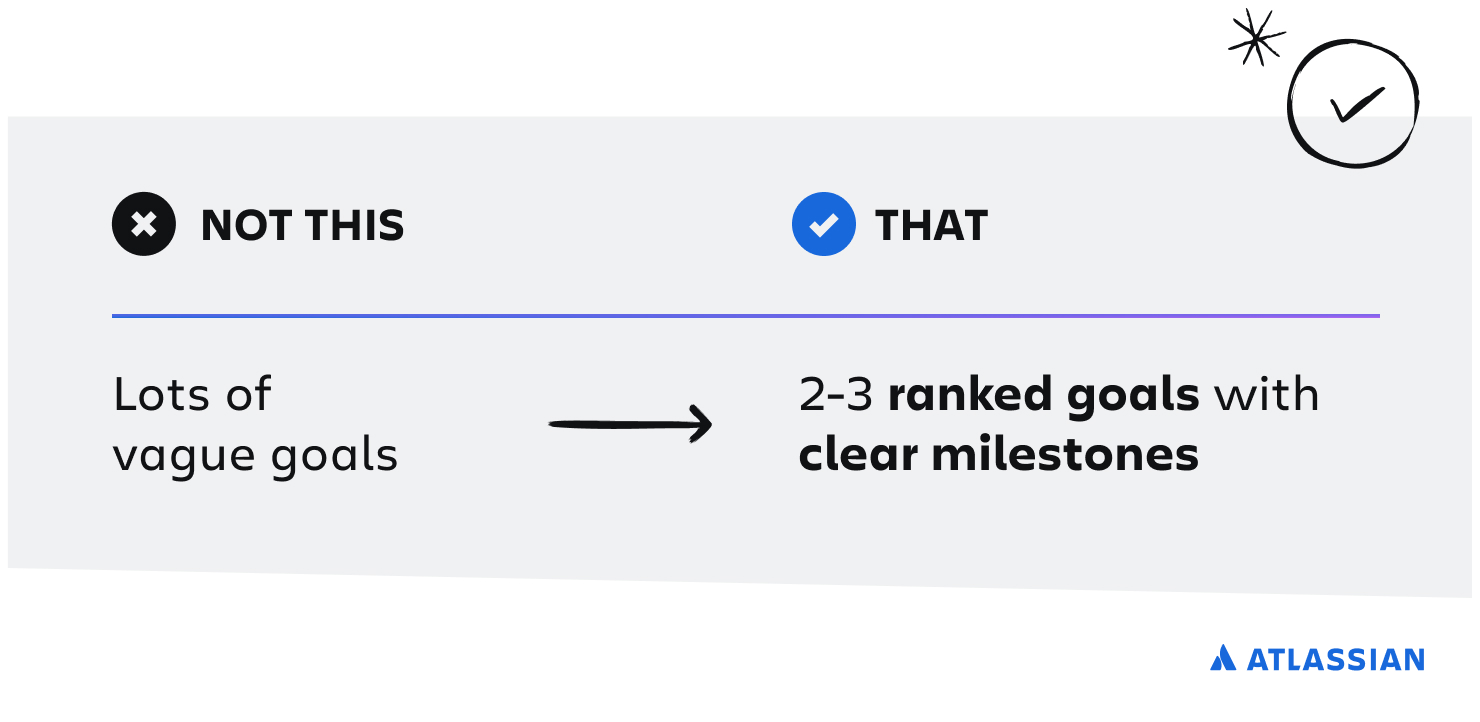
Practice 2: Make goals visible to everyone to drive goal alignment
Have goals live in one place that everyone, including AI, can easily access. Stop burying goals in docs and decks. If your team (AI included) can’t find your goals, they might as well not exist. A centralized online platform – one that shows both the goals and the work tied to them – cuts down on duplicate effort and keeps everyone moving in the same direction. No more “Wait, that was a priority?” moments.
The Atlassian Goals app helps teams make their goals and progress visible to anyone in the organization.
Talk about where goals will get you. Paint a clear, exciting vision of the future and show how today’s goals will help everyone get there. People need to understand why their daily work matters in the bigger picture. This isn’t fluff – it’s the fuel that keeps teams motivated when things get tough.
Share regular progress updates with your team. Post monthly updates for goals and weekly updates for projects to:
- keep stakeholders in the loop
- get the support your team needs to maintain momentum
- spot risks early, so you can fix them before they get worse
Try the play
Managers, check out our Weekly Team Updates Play. You’ll learn how to share updates async – through quick Loom videos or concise written messages – to save hours of meeting time while building connected teams that are crystal-clear on goals.

Practice 3: Use goals to align work to priorities
Goals shouldn’t just be aspirational statements – they should shape what actually gets done each day.
Clearly rank your goals, and make sure every project ladders up to at least one of them. When teams see how their work supports the bigger picture, they make smarter decisions about where to focus. Check in on priorities each month and adjust if needed – but don’t change direction too often. Constant shifting just creates chaos.
Redesign your workday around what matters most. Don’t let your calendar fill up by default. Be intentional. Start each day by identifying one meaningful task that moves a top goal forward – and block time to actually do it.
In an Atlassian Teamwork Lab experiment, participants redesigned their calendars around top priorities and edited their existing meetings. The result? Faster progress on high-impact work, more goal clarity, and way fewer meetings.
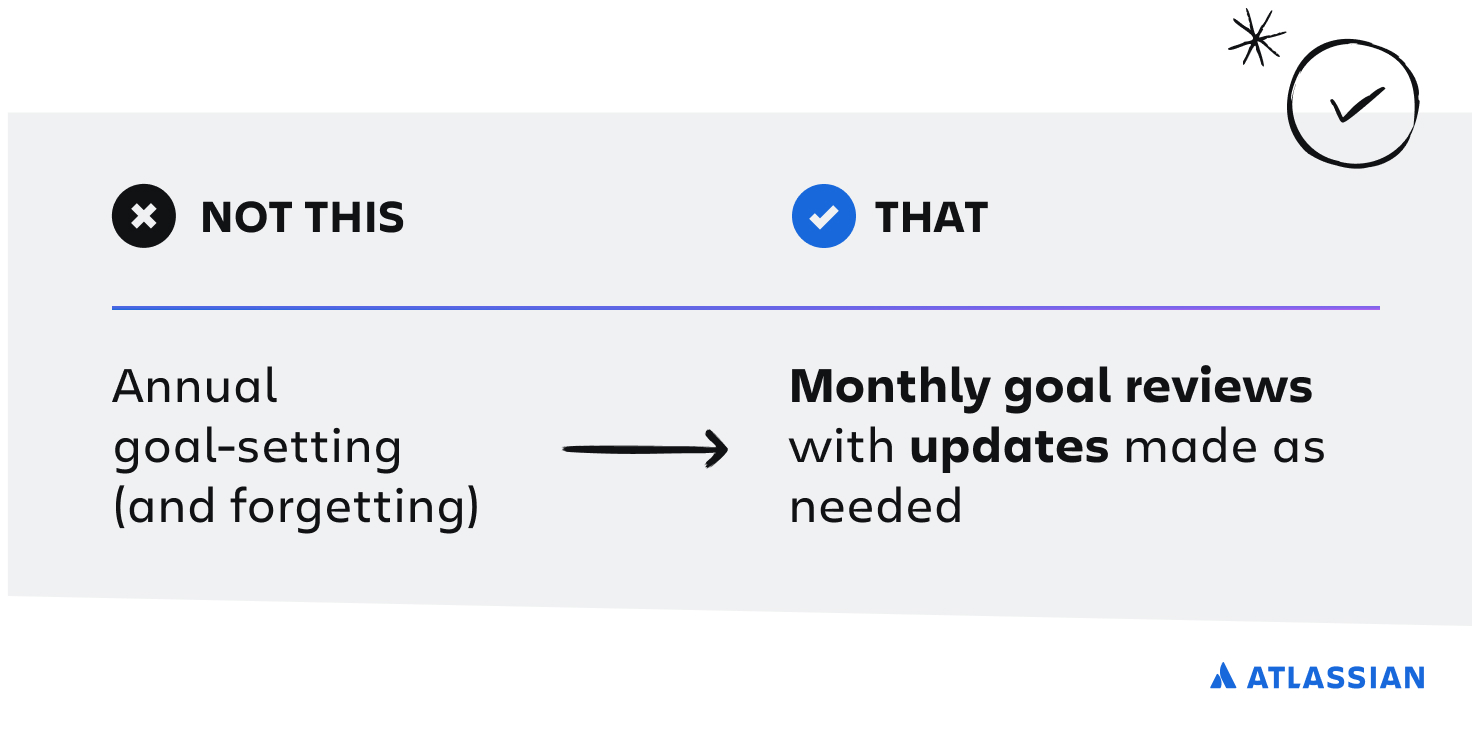
Practice makes perfect: how Atlassian got in the habit of replacing meetings
When it’s time to set goals, Atlassian’s sales leaders don’t schedule yet another meeting. Instead, they record short Loom videos to rally and align their teams. These videos live in Confluence sales enablement hubs, ready for anyone to dive into and stay laser-focused on top priorities.
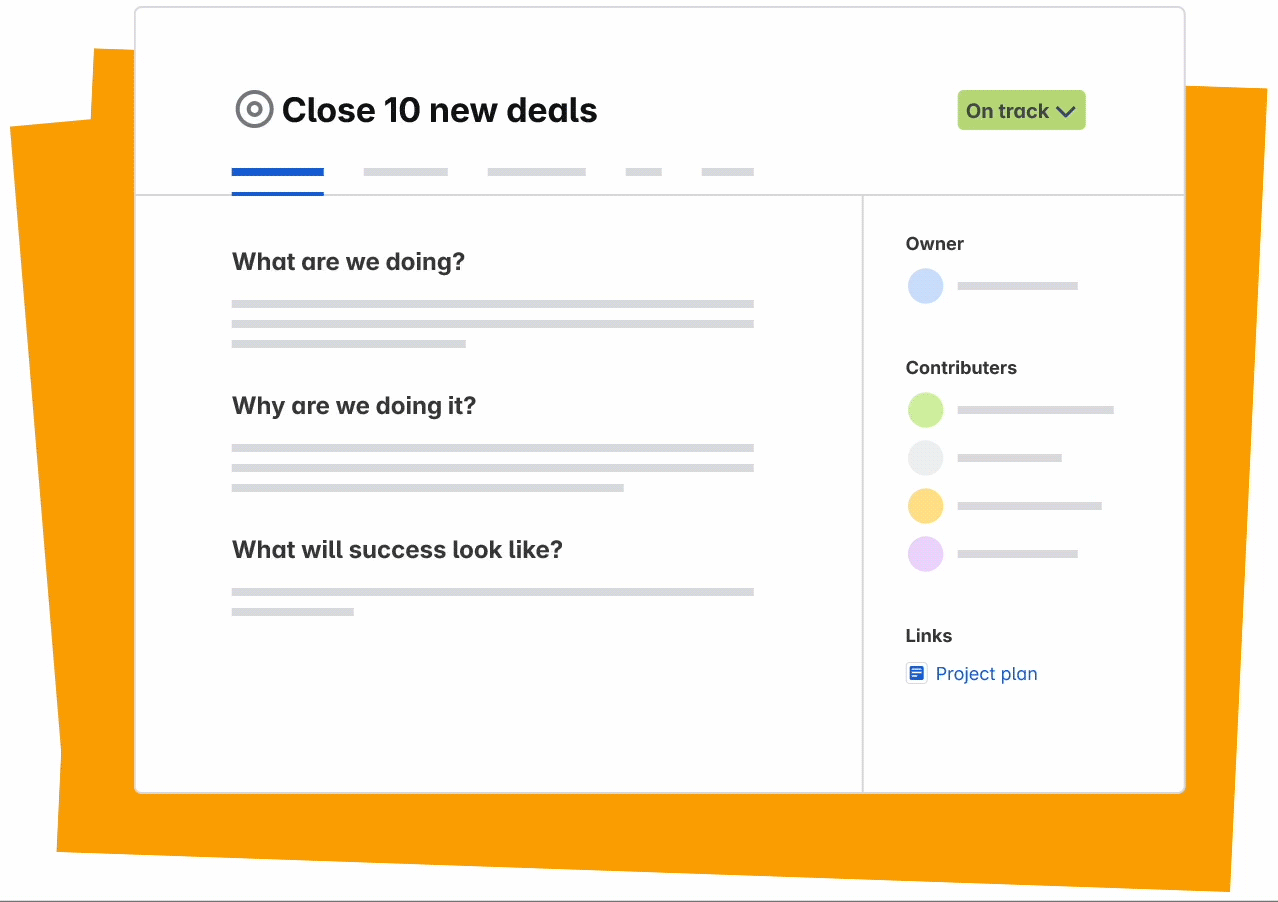
Weekly project updates? Managers now share Looms in the Atlassian Goals app – because why type out a complex customer win analysis when you can just talk it through in minutes? The best part: teammates can watch these videos on their own schedule, at 2x speed, and leave comments right on the moment in the video where they have a question.
And the numbers speak for themselves: sales team members who use Loom to create personalized video messages in prospecting have 20% higher win rates. Talk about working smarter, not harder.
Goals are our North Star. Making our individual, team, and company goals visible to everyone is the first step in working in sync.
Anu Bharadwaj, President of Atlassian
Clear goals are just one piece of the teamwork puzzle
Aligning work to goals is critical, but it’s most effective when combined with the other three pillars of the Atlassian System of Work (our core philosophy for making teamwork actually work):
- Plan and track work together: When teams are clear on how the work will get done and why they’re doing it, they move faster and make better decisions. Turning goals into concrete actions with visible progress keeps everyone aligned.
- Unleash collective knowledge: When teams document and share what they’ve learned in a central place, everyone benefits. And this way, AI can surface insights you didn’t even know you needed, cutting down time spent searching for answers.
- Realize the full power of AI teammates: AI can help teams cut through information overload, gain insights faster, and accelerate innovation cycles – but only when it’s treated as a true teammate with clear roles and responsibilities.
What could your team accomplish if everyone was truly working toward the same clear goals? It’s not just about efficiency – it’s the difference between staying busy and making a real impact.
